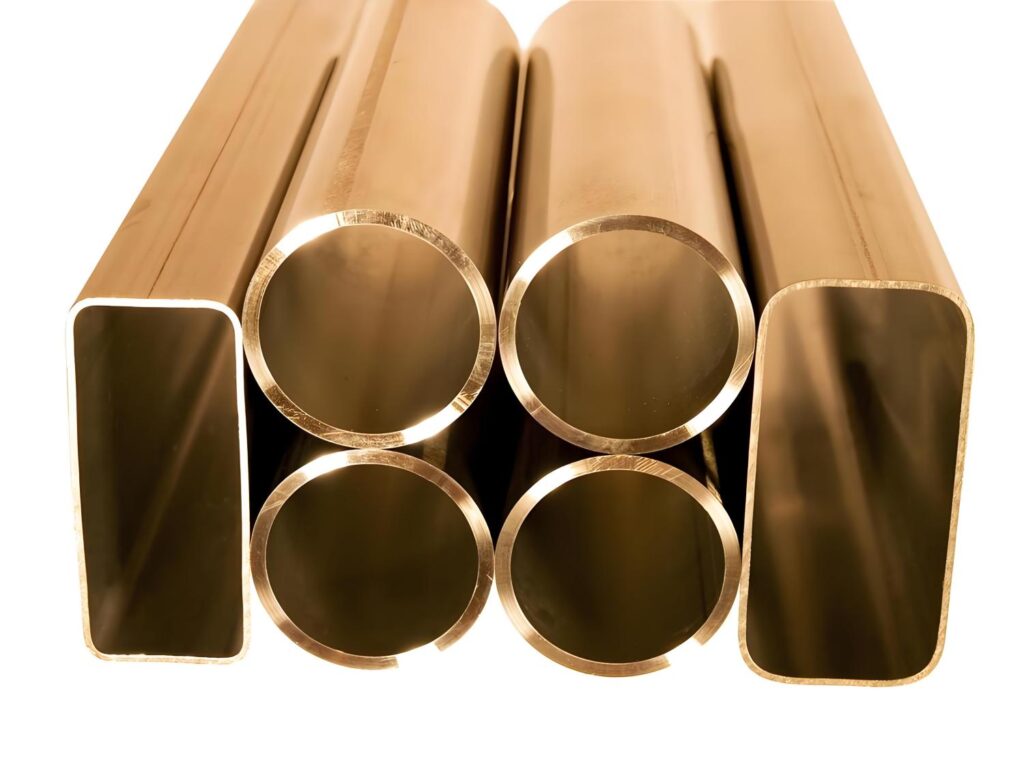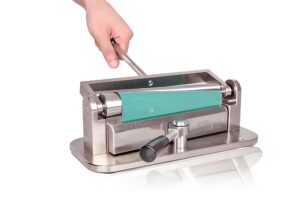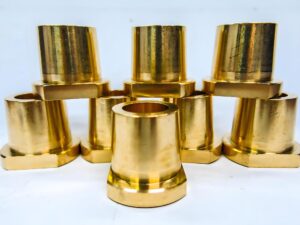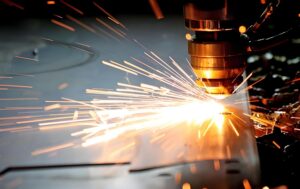What is Copper Alloy?
A copper alloy is a material formed by combining copper with one or more other elements to enhance its natural properties. Copper, in its pure form, is soft, malleable, and an excellent conductor of heat and electricity. By alloying it with metals like zinc, tin, nickel, or aluminum, manufacturers create materials with tailored characteristics suited for specific applications. These alloys retain copper’s core benefits while gaining additional strength, corrosion resistance, or other desirable traits.
The history of copper alloys dates back thousands of years. Ancient civilizations, such as the Egyptians and Romans, used bronze (a copper-tin alloy) for tools, weapons, and decorative items. Today, copper alloys are integral to industries ranging from electronics to aerospace, thanks to their versatility and adaptability.
Chemical Composition of Copper Alloy
The chemical makeup of a copper alloy depends on its intended use. Copper typically forms the base, making up 50% to 99% of the alloy’s composition, with other elements added to achieve specific properties. Common alloying elements include:
- Zinc: Forms brass, enhancing strength and corrosion resistance.
- Tin: Creates bronze, known for durability and wear resistance.
- Nickel: Produces alloys like cupronickel, valued for corrosion resistance in marine environments.
- Aluminum: Results in aluminum bronze, offering high strength and oxidation resistance.
- Lead: Improves machinability in certain alloys.
- Phosphorus: Enhances stiffness and strength in phosphor bronze.
Each combination alters the alloy’s behavior, making it suitable for diverse applications. For example, adding zinc to copper creates brass, which is widely used in plumbing and decorative fittings due to its attractive golden hue and workability.
Properties of Copper Alloy
Copper alloys are prized for their unique combination of physical and mechanical properties, making them indispensable in various sectors. Below, we explore these properties in detail.
Physical Properties
Copper alloys exhibit a range of physical characteristics that make them stand out:
- Conductivity: Copper alloys are excellent conductors of electricity and heat, though alloying slightly reduces conductivity compared to pure copper. For instance, brass conducts electricity well enough for electrical components but is less conductive than pure copper.
- Corrosion Resistance: Many copper alloys resist corrosion, especially in harsh environments like seawater. Cupronickel, for example, is a go-to material for marine applications.
- Color and Aesthetics: Copper alloys range from reddish-brown (pure copper) to golden (brass) or silvery (nickel alloys), making them popular for decorative purposes.
- Density: Copper alloys are relatively dense, though lighter than steel, with densities varying based on alloying elements.
These physical traits make copper alloys ideal for applications requiring both functionality and visual appeal.
Mechanical Properties
The mechanical properties of copper alloys determine their performance under stress and wear:
- Strength: Alloying increases copper’s tensile strength. For example, bronze is stronger than pure copper, making it suitable for heavy-duty applications.
- Malleability and Ductility: Copper alloys are highly workable, allowing them to be shaped into wires, sheets, or intricate components without breaking.
- Hardness: Alloys like phosphor bronze are harder than pure copper, improving wear resistance for bearings and gears.
- Fatigue Resistance: Many copper alloys withstand repeated stress cycles, which is critical for components like springs or connectors.
These properties ensure copper alloys can meet the demands of industries requiring robust, reliable materials.
What Are Types of Copper Alloy Grades?
Copper alloys are classified into two broad categories: wrought and cast. Each category encompasses multiple grades tailored for specific applications, distinguished by their unique composition, processing method, and performance traits.
Wrought Copper Alloys
Wrought copper alloys are mechanically worked into final shapes through processes such as rolling, drawing, forging, or extrusion. These alloys are known for their excellent mechanical strength and versatility. Common grades include:
- C11000 (Electrolytic Tough Pitch Copper)
Composed of 99.9% pure copper, this grade is widely used for electrical applications due to its outstanding electrical conductivity.
- C26000 (Cartridge Brass)
Contains approximately 70% copper and 30% zinc. It offers a good balance of strength, corrosion resistance, and formability. Frequently used in ammunition casings and hardware.
- C51000 (Phosphor Bronze)
Composed mainly of copper and tin, with a small amount of phosphorus to enhance wear resistance and fatigue strength. This grade is ideal for springs, washers, and electrical connectors.
Cast Copper Alloys
Cast copper alloys are formed by melting and pouring into molds to achieve specific shapes. These alloys generally exhibit good castability and are ideal for complex geometries. Common grades include:
- C83600 (Leaded Red Brass)
Known for its excellent machinability and corrosion resistance, this grade is often used in plumbing fittings and valves.
- C93200 (Bearing Bronze)
A tin bronze alloy with good wear resistance and load-bearing capabilities, making it ideal for bearings and bushings.
- C95500 (Aluminum Bronze)
Contains copper with aluminum and sometimes iron or nickel, offering exceptional strength and resistance to corrosion and wear. Used in marine and heavy-duty industrial applications.
Each grade offers specific benefits, making copper alloys a flexible choice across sectors such as construction, transportation, marine, and electronics. The right selection depends on performance requirements, environmental conditions, and fabrication methods.
What is Copper Alloy Used For?

Copper alloys play a vital role in numerous industries due to their diverse properties. Here are some key applications:
- Electronics: Copper alloys like brass and phosphor bronze are used in connectors, terminals, and circuit boards due to their conductivity and durability.
- Plumbing: Brass fittings and valves are common in plumbing systems, thanks to their corrosion resistance and ease of machining.
- Marine Industry: Cupronickel alloys are used in shipbuilding and offshore platforms for their ability to withstand saltwater corrosion.
- Aerospace: Aluminum bronze and beryllium copper are employed in aircraft components for their strength and lightweight properties.
- Automotive: Copper alloys appear in radiators, bearings, and electrical systems, balancing performance and cost.
- Decorative Arts: Brass and bronze are popular for sculptures, jewelry, and architectural elements due to their attractive finishes.
The adaptability of copper alloys ensures they remain a go-to material across these sectors.
Advantages and Disadvantages of Copper Alloy
Like any material, copper alloys have their strengths and limitations. Understanding these helps manufacturers make informed decisions.
Advantages
- Versatility: Copper alloys can be tailored for specific applications through alloying, offering a wide range of properties.
- Corrosion Resistance: Many alloys, especially cupronickel and bronze, resist corrosion in harsh environments.
- Conductivity: Excellent electrical and thermal conductivity makes them ideal for electronics and heat exchangers.
- Workability: Copper alloys are easily machined, cast, or forged, reducing production costs.
- Recyclability: Copper alloys are highly recyclable, supporting sustainable manufacturing practices.
Disadvantages
- Cost: Copper alloys can be more expensive than alternatives like steel or aluminum, especially for high-performance grades.
- Tarnishing: Some alloys, like brass, may tarnish over time, requiring maintenance to retain their appearance.
- Weight: Copper alloys are denser than aluminum, which may be a drawback in weight-sensitive applications.
- Reduced Conductivity: Alloying reduces copper’s natural conductivity, which may limit use in high-performance electrical applications.
Balancing these factors is key to selecting the right copper alloy for a project.
Why Choose Copper Alloys for Your Machining Needs?
Copper alloys continue to be a preferred choice for manufacturers worldwide due to their blend of strength, conductivity, and aesthetic appeal. Whether you’re crafting precision components for electronics, durable fittings for plumbing, or corrosion-resistant parts for marine environments, these materials deliver reliable performance. Their recyclability also aligns with growing demands for sustainable manufacturing.
For businesses seeking high-quality machining solutions, Precionn stands out as a trusted partner. Specializing in the machining industry, Precionn leverages advanced technology and expertise to produce precision components from copper alloys and other materials. With a commitment to quality and customer satisfaction, Precionn serves international clients through its accessible Google website, ensuring tailored solutions for diverse industries. Whether you need custom parts or expert guidance on material selection, Precionn is equipped to meet your needs with excellence.




